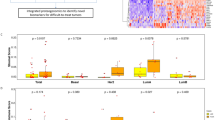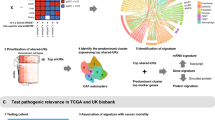Abstract
Disulfidptosis, a newly discovered cellular death mechanism initiated by disulfide stress, features elevated expression of SLC7A11 and restricted glucose availability, rendering it a possible therapeutic target for cancer. Endometrial cancer of the uterine corpus (ECUC) ranks among prevalent gynecological malignancies. Long non-coding RNAs (lncRNAs) have been implicated in ECUC’s metabolic pathways, invasive capabilities, and metastatic processes. Yet, the prognostic implications of Disulfidptosis-Linked lncRNAs (DLLs) in ECUC remain ambiguous. Transcriptome and clinical datasets related to ECUC were sourced from The Cancer Genome Atlas (TCGA), while genes linked with disulfidptosis were identified from existing literature. A panel of ten DLLs was discerned through least absolute shrinkage and selection operator (LASSO) coupled with Cox regression methods to formulate and validate risk prognostic models. We engineered a nomogram for ECUC patient prognosis forecasting and further examined the model via gene set enrichment analysis (GSEA), principal component analysis (PCA), gene set analysis (GSA), immune profiling, and sensitivity to antineoplastic agents. Prognostic models employing a set of ten DLLs (including AC005034.2, AC020765.2, AL158071.4, AL161663.2, AP000787.1, CR392039.3, EMSLR, SEC24B-AS1, Z69733.1, Z94721.3) were established. Based on median risk values, patient samples were stratified into high- and low-risk cohorts, revealing notable differences in survival across both training and validation datasets. The risk scores, when amalgamated with clinical variables, acted as standalone predictors of prognosis. GSEA findings indicated that the high-risk category predominantly aligned with pathways like extracellular matrix interactions and cell adhesion molecules, suggesting a likely association with metastatic potential. Concurrently, we scrutinized disparities in immune function and tumor mutational burden across risk categories and identified anticancer drugs with likely efficacy. In summary, a set of ten DLLs proved useful in forecasting patient outcomes and holds potential for informing targeted therapeutic approaches in ECUC.
Graphical abstract










Similar content being viewed by others
Data Availability
The data presented in this study are available on request from the corresponding author.
References
Crosbie EJ, Kitson SJ, McAlpine JN, et al. Endometrial cancer. Lancet. 2022;399:1412–28. https://doi.org/10.1016/S0140-6736(22)00323-3.
Oaknin A, Bosse TJ, Creutzberg CL, et al. Endometrial cancer: ESMO clinical practice guideline for diagnosis, treatment and follow-up. Ann Oncol. 2022;33:860–77. https://doi.org/10.1016/j.annonc.2022.05.009.
Makker V, MacKay H, Ray-Coquard I, et al. Endometrial cancer. Nat Rev Dis Primers. 2021;7:88. https://doi.org/10.1038/s41572-021-00324-8.
Brooks RA, Fleming GF, Lastra RR, et al. Current recommendations and recent progress in endometrial cancer. CA Cancer J Clin. 2019;69:258–79. https://doi.org/10.3322/caac.21561.
Liu X, Nie L, Zhang Y, et al. Actin cytoskeleton vulnerability to disulfide stress mediates disulfidptosis. Nat Cell Biol. 2023;25:404–14. https://doi.org/10.1038/s41556-023-01091-2.
Jiang L, Kon N, Li T, et al. Ferroptosis as a p53-mediated activity during tumour suppression. Nature. 2015;520:57–62. https://doi.org/10.1038/nature14344.
Yang J, Zhou Y, Xie S, et al. Metformin induces ferroptosis by inhibiting UFMylation of SLC7A11 in breast cancer. J Exp Clin Cancer Res. 2021;40:206. https://doi.org/10.1186/s13046-021-02012-7.
Yuan S, Wei C, Liu G, et al. Sorafenib attenuates liver fibrosis by triggering hepatic stellate cell ferroptosis via HIF-1alpha/SLC7A11 pathway. Cell Prolif. 2022;55:e13158. https://doi.org/10.1111/cpr.13158.
Wang X, Chen Y, Wang X, et al. Stem cell factor SOX2 confers ferroptosis resistance in lung cancer via upregulation of SLC7A11. Cancer Res. 2021;81:5217–29. https://doi.org/10.1158/0008-5472.CAN-21-0567.
Zheng P, Zhou C, Ding Y, et al. Disulfidptosis: a new target for metabolic cancer therapy. J Exp Clin Cancer Res. 2023;42:103. https://doi.org/10.1186/s13046-023-02675-4.
Ashrafizadeh M, Rabiee N, Kumar AP, et al. Long noncoding RNAs (lncRNAs) in pancreatic cancer progression. Drug Discov Today. 2022;27:2181–98. https://doi.org/10.1016/j.drudis.2022.05.012.
Xie W, Chu M, Song G, et al. Emerging roles of long noncoding RNAs in chemoresistance of pancreatic cancer. Semin Cancer Biol. 2022;83:303–18. https://doi.org/10.1016/j.semcancer.2020.11.004.
Liu SJ, Dang HX, Lim DA, et al. Long noncoding RNAs in cancer metastasis. Nat Rev Cancer. 2021;21:446–60. https://doi.org/10.1038/s41568-021-00353-1.
Zhou B, Yang H, Yang C, et al. Translation of noncoding RNAs and cancer. Cancer Lett. 2021;497:89–99. https://doi.org/10.1016/j.canlet.2020.10.002.
Urick ME, Bell DW. Clinical actionability of molecular targets in endometrial cancer. Nat Rev Cancer. 2019;19:510–21. https://doi.org/10.1038/s41568-019-0177-x.
Yang H, Hu Y, Weng M, et al. Hypoxia inducible lncRNA-CBSLR modulates ferroptosis through m6A-YTHDF2-dependent modulation of CBS in gastric cancer. J Adv Res. 2022;37:91–106. https://doi.org/10.1016/j.jare.2021.10.001.
Liu Z, Liu L, Weng S, et al. Machine learning-based integration develops an immune-derived lncRNA signature for improving outcomes in colorectal cancer. Nat Commun. 2022;13:816. https://doi.org/10.1038/s41467-022-28421-6.
Liu S, Sun Y, Hou Y, et al. A novel lncRNA ROPM-mediated lipid metabolism governs breast cancer stem cell properties. J Hematol Oncol. 2021;14:178. https://doi.org/10.1186/s13045-021-01194-z.
Shetty A, Venkatesh T, Kabbekodu SP, et al. LncRNA-miRNA-mRNA regulatory axes in endometrial cancer: a comprehensive overview. Arch Gynecol Obstet. 2022;306:1431–47. https://doi.org/10.1007/s00404-022-06423-5.
Priyanka P, Sharma M, Das S, et al. E2F1-induced lncRNA, EMSLR regulates lncRNA LncPRESS1. Sci Rep. 2022;12:2548. https://doi.org/10.1038/s41598-022-06154-2.
Hu J, Zhang PJ, Zhang D, et al. An autophagy-associated lncRNAs model for predicting the survival in non-small cell lung cancer patients. Front Genet. 2022;13:919857. https://doi.org/10.3389/fgene.2022.919857.
Bai Y, Zhang Q, Liu F, et al. A novel cuproptosis-related lncRNA signature predicts the prognosis and immune landscape in bladder cancer. Front Immunol. 2022;13:1027449. https://doi.org/10.3389/fimmu.2022.1027449.
Torrino S, Grasset EM, Audebert S, et al. Mechano-induced cell metabolism promotes microtubule glutamylation to force metastasis. Cell Metab. 2021;33:1342–1357.e10. https://doi.org/10.1016/j.cmet.2021.05.009.
Priyanga J, Guha G, Bhakta-Guha D. Microtubule motors in centrosome homeostasis: a target for cancer therapy? Biochim Biophys Acta Rev Cancer. 2021;1875:188524. https://doi.org/10.1016/j.bbcan.2021.188524.
Liu H, Kiseleva AA, Golemis EA. Ciliary signalling in cancer. Nat Rev Cancer. 2018;18:511–24. https://doi.org/10.1038/s41568-018-0023-6.
Song L, Wang Y, Zhang J, et al. The risks of cancer development in systemic lupus erythematosus (SLE) patients: a systematic review and meta-analysis. Arthritis Res Ther. 2018;20:270. https://doi.org/10.1186/s13075-018-1760-3.
Wu B, Liu DA, Guan L, et al. Stiff matrix induces exosome secretion to promote tumour growth. Nat Cell Biol. 2023;25:415–24. https://doi.org/10.1038/s41556-023-01092-1.
Ichikawa T, Okugawa Y, Toiyama Y, et al. Clinical significance and biological role of L1 cell adhesion molecule in gastric cancer. Br J Cancer. 2019;121:1058–68. https://doi.org/10.1038/s41416-019-0646-8.
Gong W, Donnelly CR, Heath BR, et al. Cancer-specific type-I interferon receptor signaling promotes cancer stemness and effector CD8+ T-cell exhaustion. Oncoimmunology. 2021;10:1997385. https://doi.org/10.1080/2162402X.2021.1997385.
Aehnlich P, Powell RM, Peeters MJW, et al. TAM receptor inhibition-implications for cancer and the immune system. Cancers (Basel). 2021;13(6):1195. https://doi.org/10.3390/cancers13061195.
Aran D, Lasry A, Zinger A, et al. Widespread parainflammation in human cancer. Genome Biol. 2016;17:145. https://doi.org/10.1186/s13059-016-0995-z.
Addeo A, Friedlaender A, Banna GL, et al. TMB or not TMB as a biomarker: that is the question. Crit Rev Oncol Hematol. 2021;163:103374. https://doi.org/10.1016/j.critrevonc.2021.103374.
Author information
Authors and Affiliations
Contributions
SS, HL, and XT initiated the study and designed the experiments. SS and HL performed data collection and analysis. XT helped with discussion and interpretation of results. SS wrote the manuscript.
Corresponding author
Ethics declarations
Informed Consent
Not applicable.
Conflict of Interest
The authors declare no competing interests.
Institutional Review Board Statement
Not applicable.
Additional information
Publisher’s Note
Springer Nature remains neutral with regard to jurisdictional claims in published maps and institutional affiliations.
Rights and permissions
Springer Nature or its licensor (e.g. a society or other partner) holds exclusive rights to this article under a publishing agreement with the author(s) or other rightsholder(s); author self-archiving of the accepted manuscript version of this article is solely governed by the terms of such publishing agreement and applicable law.
About this article
Cite this article
Shi, S., Tang, X. & Liu, H. Disulfidptosis-Related lncRNA for the Establishment of Novel Prognostic Signature and Therapeutic Response Prediction to Endometrial Cancer. Reprod. Sci. 31, 811–822 (2024). https://doi.org/10.1007/s43032-023-01382-x
Received:
Accepted:
Published:
Issue Date:
DOI: https://doi.org/10.1007/s43032-023-01382-x




